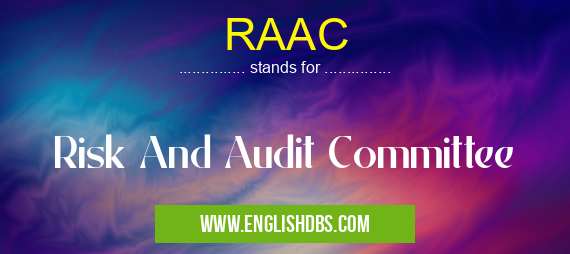What does RAAC mean in COMMITTEES
RAAC stands for Risk And Audit Committee. It is a committee of a company's board of directors that is responsible for overseeing the company's risk management and internal audit functions. The RAAC typically consists of independent directors who have expertise in risk management, auditing, and finance.

RAAC meaning in Committees in Community
RAAC mostly used in an acronym Committees in Category Community that means Risk And Audit Committee
Shorthand: RAAC,
Full Form: Risk And Audit Committee
For more information of "Risk And Audit Committee", see the section below.
» Community » Committees
Role and responsibilities of RAAC
- Monitoring the company's risk management framework and ensuring its effectiveness
- Reviewing the company's internal audit function and making recommendations for improvement
- Providing oversight of the company's financial reporting process
- Communicating with the company's management and external auditors on risk management and internal audit matters
Essential Questions and Answers on Risk And Audit Committee in "COMMUNITY»COMMITTEES"
What is the Role of the RAAC?
The Risk And Audit Committee (RAAC) is responsible for overseeing an organization's risk management and internal audit functions. It provides independent assurance to the board of directors that the organization has adequate controls in place to manage risks and ensure financial reporting integrity.
Who are the Members of the RAAC?
RAAC members are typically non-executive directors who possess expertise in risk management, finance, or auditing. They are appointed by the board of directors and serve on a voluntary basis.
What are the Key Responsibilities of the RAAC?
The RAAC has several key responsibilities, including:
- Reviewing and approving the organization's risk management framework
- Overseeing the internal audit function
- Ensuring the organization complies with relevant laws and regulations
- Reporting to the board of directors on its activities and findings
How Does the RAAC Report to the Board?
The RAAC typically reports to the board of directors through the chair of the committee. The report may include information on the committee's activities, findings, and recommendations.
How Does the RAAC Work with the Internal Audit Function?
The RAAC provides oversight and guidance to the internal audit function. It approves the internal audit plan, reviews audit reports, and monitors the implementation of audit recommendations.
What are the Benefits of Having a RAAC?
An effective RAAC can provide several benefits to an organization, including:
- Improved risk management
- Enhanced financial reporting reliability
- Increased stakeholder confidence
- Compliance with regulatory requirements
Final Words: The RAAC plays an important role in ensuring the sound management of risk and the integrity of financial reporting. By providing independent oversight of these functions, the RAAC helps to protect the interests of the company's shareholders and other stakeholders.
RAAC also stands for: |
|
| All stands for RAAC |
